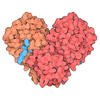[English] 日本語
 Yorodumi
Yorodumi- PDB-3i6l: Newly identified epitope N1 derived from SARS-CoV N protein compl... -
+ Open data
Open data
- Basic information
Basic information
| Entry | Database: PDB / ID: 3i6l | ||||||
|---|---|---|---|---|---|---|---|
| Title | Newly identified epitope N1 derived from SARS-CoV N protein complexed with HLA-A*2402 | ||||||
 Components Components |
| ||||||
 Keywords Keywords | IMMUNE SYSTEM / HLA-A*2402 / SARS-CoV / nucleocapsid protein / Disulfide bond / Glycoprotein / Host-virus interaction / Immune response / Membrane / MHC I / Transmembrane / Disease mutation / Glycation / Immunoglobulin domain / Pyrrolidone carboxylic acid / Secreted / Golgi apparatus / Phosphoprotein / Ribonucleoprotein / RNA-binding / Viral nucleoprotein / Virion | ||||||
| Function / homology |  Function and homology information Function and homology informationSARS-CoV-1-host interactions / Translation of Structural Proteins / Virion Assembly and Release / viral RNA genome packaging / Transcription of SARS-CoV-1 sgRNAs / negative regulation of interferon-beta production / Maturation of nucleoprotein / positive regulation of memory T cell activation / T cell mediated cytotoxicity directed against tumor cell target / TAP complex binding ...SARS-CoV-1-host interactions / Translation of Structural Proteins / Virion Assembly and Release / viral RNA genome packaging / Transcription of SARS-CoV-1 sgRNAs / negative regulation of interferon-beta production / Maturation of nucleoprotein / positive regulation of memory T cell activation / T cell mediated cytotoxicity directed against tumor cell target / TAP complex binding / Golgi medial cisterna / positive regulation of CD8-positive, alpha-beta T cell activation / CD8-positive, alpha-beta T cell activation / positive regulation of CD8-positive, alpha-beta T cell proliferation / CD8 receptor binding / antigen processing and presentation of exogenous peptide antigen via MHC class I / beta-2-microglobulin binding / endoplasmic reticulum exit site / TAP binding / antigen processing and presentation of endogenous peptide antigen via MHC class I via ER pathway, TAP-dependent / SARS-CoV-1 modulates host translation machinery / protection from natural killer cell mediated cytotoxicity / antigen processing and presentation of endogenous peptide antigen via MHC class Ib / antigen processing and presentation of endogenous peptide antigen via MHC class I via ER pathway, TAP-independent / detection of bacterium / T cell receptor binding / SARS-CoV-1 targets host intracellular signalling and regulatory pathways / Attachment and Entry / negative regulation of receptor binding / early endosome lumen / Nef mediated downregulation of MHC class I complex cell surface expression / DAP12 interactions / transferrin transport / cellular response to iron ion / Endosomal/Vacuolar pathway / Antigen Presentation: Folding, assembly and peptide loading of class I MHC / peptide antigen assembly with MHC class II protein complex / lumenal side of endoplasmic reticulum membrane / cellular response to iron(III) ion / MHC class II protein complex / negative regulation of forebrain neuron differentiation / antigen processing and presentation of exogenous protein antigen via MHC class Ib, TAP-dependent / ER to Golgi transport vesicle membrane / peptide antigen assembly with MHC class I protein complex / regulation of iron ion transport / regulation of erythrocyte differentiation / HFE-transferrin receptor complex / response to molecule of bacterial origin / MHC class I peptide loading complex / T cell mediated cytotoxicity / positive regulation of T cell cytokine production / antigen processing and presentation of endogenous peptide antigen via MHC class I / antigen processing and presentation of exogenous peptide antigen via MHC class II / positive regulation of immune response / MHC class I protein complex / positive regulation of T cell activation / peptide antigen binding / positive regulation of receptor-mediated endocytosis / negative regulation of neurogenesis / cellular response to nicotine / positive regulation of T cell mediated cytotoxicity / multicellular organismal-level iron ion homeostasis / specific granule lumen / positive regulation of type II interferon production / phagocytic vesicle membrane / recycling endosome membrane / Interferon gamma signaling / Immunoregulatory interactions between a Lymphoid and a non-Lymphoid cell / negative regulation of epithelial cell proliferation / MHC class II protein complex binding / SARS-CoV-1 activates/modulates innate immune responses / Interferon alpha/beta signaling / Modulation by Mtb of host immune system / viral capsid / late endosome membrane / sensory perception of smell / positive regulation of cellular senescence / antibacterial humoral response / tertiary granule lumen / DAP12 signaling / T cell differentiation in thymus / T cell receptor signaling pathway / E3 ubiquitin ligases ubiquitinate target proteins / negative regulation of neuron projection development / ER-Phagosome pathway / protein refolding / viral nucleocapsid / host cell endoplasmic reticulum-Golgi intermediate compartment / early endosome membrane / protein homotetramerization / host cell Golgi apparatus / amyloid fibril formation / molecular adaptor activity / intracellular iron ion homeostasis / learning or memory / defense response to Gram-positive bacterium / immune response / host cell perinuclear region of cytoplasm / endoplasmic reticulum lumen / ribonucleoprotein complex Similarity search - Function | ||||||
| Biological species |  Homo sapiens (human) Homo sapiens (human) | ||||||
| Method |  X-RAY DIFFRACTION / X-RAY DIFFRACTION /  MOLECULAR REPLACEMENT / Resolution: 2.4 Å MOLECULAR REPLACEMENT / Resolution: 2.4 Å | ||||||
 Authors Authors | Liu, J.W. | ||||||
 Citation Citation |  Journal: J.Virol. / Year: 2010 Journal: J.Virol. / Year: 2010Title: Novel immunodominant peptide presentation strategy: a featured HLA-A*2402-restricted cytotoxic T-lymphocyte epitope stabilized by intrachain hydrogen bonds from severe acute respiratory ...Title: Novel immunodominant peptide presentation strategy: a featured HLA-A*2402-restricted cytotoxic T-lymphocyte epitope stabilized by intrachain hydrogen bonds from severe acute respiratory syndrome coronavirus nucleocapsid protein Authors: Liu, J. / Wu, P. / Gao, F. / Qi, J. / Kawana-Tachikawa, A. / Xie, J. / Vavricka, C.J. / Iwamoto, A. / Li, T. / Gao, G.F. | ||||||
| History |
|
- Structure visualization
Structure visualization
| Structure viewer | Molecule:  Molmil Molmil Jmol/JSmol Jmol/JSmol |
|---|
- Downloads & links
Downloads & links
- Download
Download
| PDBx/mmCIF format |  3i6l.cif.gz 3i6l.cif.gz | 96.8 KB | Display |  PDBx/mmCIF format PDBx/mmCIF format |
|---|---|---|---|---|
| PDB format |  pdb3i6l.ent.gz pdb3i6l.ent.gz | 73.1 KB | Display |  PDB format PDB format |
| PDBx/mmJSON format |  3i6l.json.gz 3i6l.json.gz | Tree view |  PDBx/mmJSON format PDBx/mmJSON format | |
| Others |  Other downloads Other downloads |
-Validation report
| Summary document |  3i6l_validation.pdf.gz 3i6l_validation.pdf.gz | 443.1 KB | Display |  wwPDB validaton report wwPDB validaton report |
|---|---|---|---|---|
| Full document |  3i6l_full_validation.pdf.gz 3i6l_full_validation.pdf.gz | 449.8 KB | Display | |
| Data in XML |  3i6l_validation.xml.gz 3i6l_validation.xml.gz | 19.2 KB | Display | |
| Data in CIF |  3i6l_validation.cif.gz 3i6l_validation.cif.gz | 27.3 KB | Display | |
| Arichive directory |  https://data.pdbj.org/pub/pdb/validation_reports/i6/3i6l https://data.pdbj.org/pub/pdb/validation_reports/i6/3i6l ftp://data.pdbj.org/pub/pdb/validation_reports/i6/3i6l ftp://data.pdbj.org/pub/pdb/validation_reports/i6/3i6l | HTTPS FTP |
-Related structure data
| Related structure data | 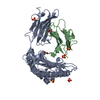 2bckS S: Starting model for refinement |
|---|---|
| Similar structure data |
- Links
Links
- Assembly
Assembly
| Deposited unit | 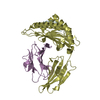
| ||||||||
|---|---|---|---|---|---|---|---|---|---|
| 1 |
| ||||||||
| Unit cell |
|
- Components
Components
| #1: Protein | Mass: 31551.889 Da / Num. of mol.: 1 / Fragment: alpha 1-3 regions, UNP residues 25-298 Source method: isolated from a genetically manipulated source Source: (gene. exp.)  Homo sapiens (human) / Gene: HLA-A, HLAA, MHC class I antigen HLA-A*2402 / Plasmid: pET28a / Production host: Homo sapiens (human) / Gene: HLA-A, HLAA, MHC class I antigen HLA-A*2402 / Plasmid: pET28a / Production host:  |
|---|---|
| #2: Protein | Mass: 11879.356 Da / Num. of mol.: 1 Source method: isolated from a genetically manipulated source Source: (gene. exp.)  Homo sapiens (human) / Gene: B2M, beta-2-microglobulin, CDABP0092, HDCMA22P / Plasmid: pGMT7 / Production host: Homo sapiens (human) / Gene: B2M, beta-2-microglobulin, CDABP0092, HDCMA22P / Plasmid: pGMT7 / Production host:  |
| #3: Protein/peptide | Mass: 1090.292 Da / Num. of mol.: 1 / Fragment: UNP residue 346-354 / Source method: obtained synthetically / Details: chemical synthesized / Source: (synth.)  |
| #4: Water | ChemComp-HOH / |
| Has protein modification | Y |
-Experimental details
-Experiment
| Experiment | Method:  X-RAY DIFFRACTION / Number of used crystals: 1 X-RAY DIFFRACTION / Number of used crystals: 1 |
|---|
- Sample preparation
Sample preparation
| Crystal | Density Matthews: 3.13 Å3/Da / Density % sol: 60.7 % |
|---|---|
| Crystal grow | Temperature: 277 K / Method: vapor diffusion, hanging drop / pH: 8.9 Details: 0.2M Ammonium sulfate, 0.1M Tris pH 8.9, 25% w/v Polyethylene glycol 3350, VAPOR DIFFUSION, HANGING DROP, temperature 277K |
-Data collection
| Diffraction | Mean temperature: 100 K |
|---|---|
| Diffraction source | Source:  ROTATING ANODE / Type: RIGAKU MICROMAX-007 / Wavelength: 1.54178 Å ROTATING ANODE / Type: RIGAKU MICROMAX-007 / Wavelength: 1.54178 Å |
| Detector | Type: RIGAKU RAXIS VII / Detector: IMAGE PLATE / Date: Jun 12, 2008 |
| Radiation | Protocol: SINGLE WAVELENGTH / Monochromatic (M) / Laue (L): M / Scattering type: x-ray |
| Radiation wavelength | Wavelength: 1.54178 Å / Relative weight: 1 |
| Reflection | Resolution: 2.4→28.94 Å / Num. obs: 22272 / % possible obs: 98.6 % / Observed criterion σ(F): 3 / Observed criterion σ(I): 3 / Redundancy: 6.7 % / Biso Wilson estimate: 43.5 Å2 / Rmerge(I) obs: 0.099 / Rsym value: 0.099 / Net I/σ(I): 40.671 / Num. measured all: 149410 |
| Reflection shell | Resolution: 2.4→2.49 Å / Redundancy: 6.8 % / Rmerge(I) obs: 0.387 / Mean I/σ(I) obs: 6.211 / Num. unique all: 2166 / Rsym value: 0.387 / % possible all: 97.5 |
- Processing
Processing
| Software |
| ||||||||||||||||||||||||||||||||||||||||||||||||||||||||||||||||||||||||||||||||||||||||||||||||||||||||||||||||||||||||||||||||||||||||||||||||||||||||||||||||||||||||||
|---|---|---|---|---|---|---|---|---|---|---|---|---|---|---|---|---|---|---|---|---|---|---|---|---|---|---|---|---|---|---|---|---|---|---|---|---|---|---|---|---|---|---|---|---|---|---|---|---|---|---|---|---|---|---|---|---|---|---|---|---|---|---|---|---|---|---|---|---|---|---|---|---|---|---|---|---|---|---|---|---|---|---|---|---|---|---|---|---|---|---|---|---|---|---|---|---|---|---|---|---|---|---|---|---|---|---|---|---|---|---|---|---|---|---|---|---|---|---|---|---|---|---|---|---|---|---|---|---|---|---|---|---|---|---|---|---|---|---|---|---|---|---|---|---|---|---|---|---|---|---|---|---|---|---|---|---|---|---|---|---|---|---|---|---|---|---|---|---|---|---|---|
| Refinement | Method to determine structure:  MOLECULAR REPLACEMENT MOLECULAR REPLACEMENTStarting model: PDB ENTRY 2BCK Resolution: 2.4→28.94 Å / Cor.coef. Fo:Fc: 0.94 / Cor.coef. Fo:Fc free: 0.897 / SU B: 8.68 / SU ML: 0.205 / Cross valid method: THROUGHOUT / ESU R: 0.349 / ESU R Free: 0.279 / Stereochemistry target values: MAXIMUM LIKELIHOOD / Details: HYDROGENS HAVE BEEN ADDED IN THE RIDING POSITIONS
| ||||||||||||||||||||||||||||||||||||||||||||||||||||||||||||||||||||||||||||||||||||||||||||||||||||||||||||||||||||||||||||||||||||||||||||||||||||||||||||||||||||||||||
| Solvent computation | Ion probe radii: 0.8 Å / Shrinkage radii: 0.8 Å / VDW probe radii: 1.2 Å / Solvent model: MASK | ||||||||||||||||||||||||||||||||||||||||||||||||||||||||||||||||||||||||||||||||||||||||||||||||||||||||||||||||||||||||||||||||||||||||||||||||||||||||||||||||||||||||||
| Displacement parameters | Biso mean: 43.465 Å2
| ||||||||||||||||||||||||||||||||||||||||||||||||||||||||||||||||||||||||||||||||||||||||||||||||||||||||||||||||||||||||||||||||||||||||||||||||||||||||||||||||||||||||||
| Refinement step | Cycle: LAST / Resolution: 2.4→28.94 Å
| ||||||||||||||||||||||||||||||||||||||||||||||||||||||||||||||||||||||||||||||||||||||||||||||||||||||||||||||||||||||||||||||||||||||||||||||||||||||||||||||||||||||||||
| Refine LS restraints |
| ||||||||||||||||||||||||||||||||||||||||||||||||||||||||||||||||||||||||||||||||||||||||||||||||||||||||||||||||||||||||||||||||||||||||||||||||||||||||||||||||||||||||||
| LS refinement shell | Resolution: 2.398→2.46 Å / Total num. of bins used: 20
|
 Movie
Movie Controller
Controller


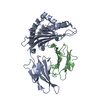

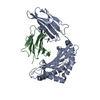
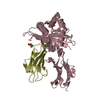



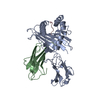


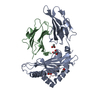

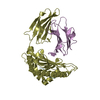

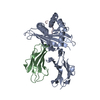

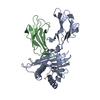
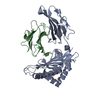

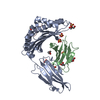
 PDBj
PDBj


